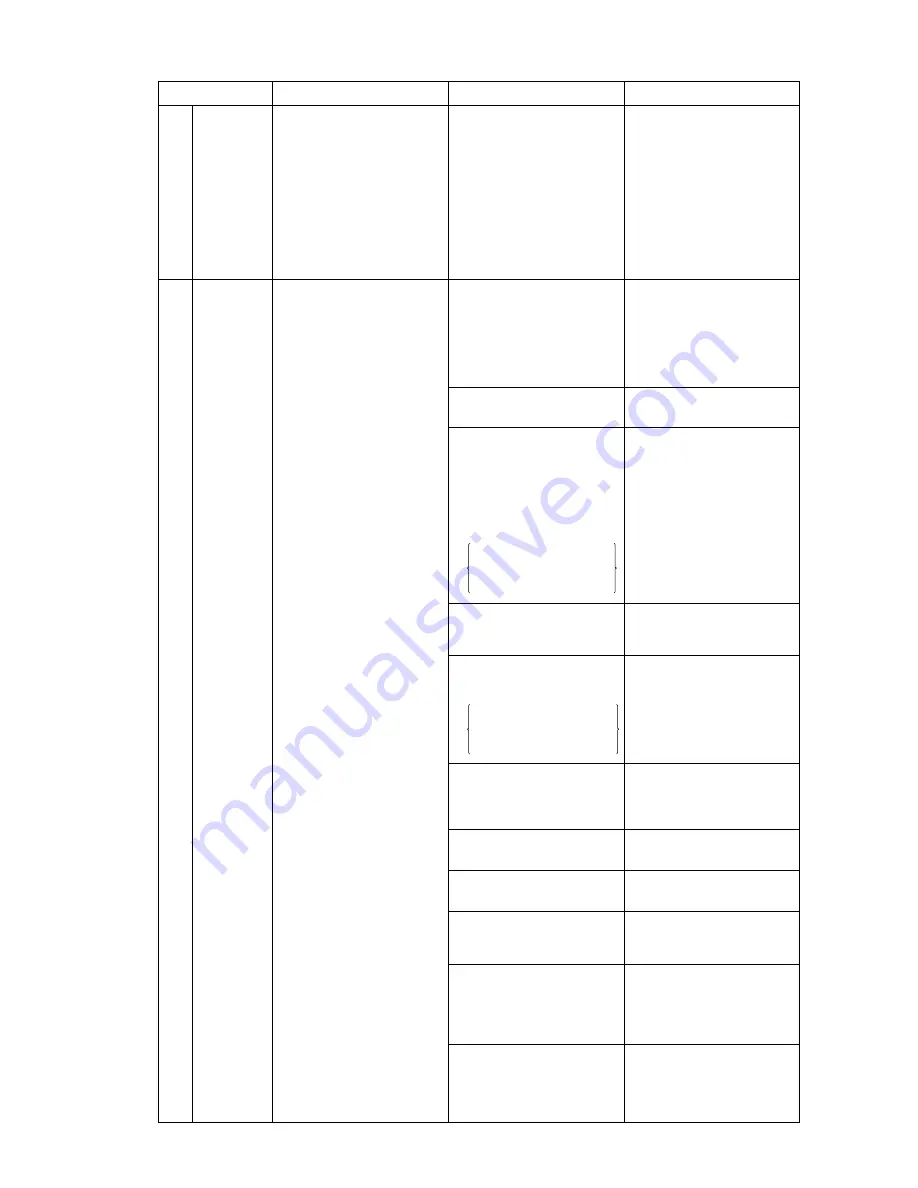
- 99 -
Checking code
1301
Meaning, detecting method
Cause
Checking method & Countermeasure
Low pressure
abnoramlity
When starting the compressor
from Stop Mode for the first time
(include the time when starting
the compressor for the next time,
when starting bound power,
ending bound power or when
the thermo turns off just after
the remote controller is turned
on), check the low-pressure
sensor beforehand. If the sensor
is 0.098MPa, stop the operation
immediately after starting.
(1) Internal pressure is dropping
due to a gas leak.
(2) The low pressure pressure
sensor is defective.
(3) Insulation is torn.
(4) A pin is missing in the
connector, or there is faulty
contact.
(5) A wire is disconnected.
(6) The control board’s low
pressure pressure sensor
input circuit is defective.
Refer to the item on judging low
pressure pressure sensor failure.
1302 High pressure
abnoramlity 1
(Outdoor unit)
1. When pressure sensor
detects 3.87MPa or more
during operations (the first
time), outdoor unit stops once,
mode is changed to restart
mode after 3 minutes, then
the outdoor unit restarts.
2. When a pressure of 3.87MPa
or more is detected again (the
second time) within 30
minutes after first stop of
outdoor unit, mode is
changed to restart mode after
3 minutes, then the outdoor
unit restarts.
3. When 3.87MPa or more
pressure is detected again
(the third time) within 30
minutes after stop of outdoor
unit, error stop is observed
with code No. “1302”
displayed.
4. When 3.87MPa or more
pressure is detected 30 or
more minutes after stop of
outdoor unit, the detection is
regarded as the first time and
the process shown in 1. is
observed.
5. 30 minutes after stop of
outdoor unit is intermittent
fault check period with LED
displayed.
6. Error stop is observed
immediately when pressure
switch (4.15 MPa) operates
in addition to pressure sensor.
(1) Poor operations of indoor
LEV
→
Heating
(2) Poor operations of ball valve.
(3) Short cycle of indoor unit.
(4) Clogging of indoor unit filter.
(5) Fall in air volume caused by
dust on indoor unit fan.
(6) Dust on indoor unit heat
exchanger.
(7) Indoor unit fan block, motor
trouble.
(2)~(7) : Rise in high pressure
caused by lowered condensing
capacity in heating-only and
heating-main operation.
(8) Short cycle of outdoor unit.
(9) Dust on outdoor unit heat
exchanger.
(10) Outdoor unit fan block,
motor trouble, poor
operations of fan controller.
(8)~(10) : Rise in high pressure
caused by lowered condensing
capacity in cooling-only and
cooling-main operation.
(11) Poor operations of solenoid
valves SV1 (Bypass valves
(SV1) can not control rise
in high pressure).
(12) Thermistor trouble
(TH5, TH6).
(13) Pressure sensor trouble.
(14) Control circuit board
thermistor trouble, pressure
sensor input circuit trouble.
(15) Thermistor mounting failure
(TH5, TH6)
(16) No connector for pressure
switch (63H), disconnected
wire.
(17) Fuse melting on the control
board (F01 or F02).
Check operations status by
actually performing cooling or
heating operations.
Heating : Indoor LEV
See
Trouble check of LEV and
solenoid valve.
Confirm that ball valve is fully
opened.
Check indoor unit and take
measures to trouble.
Check outdoor unit and take
measures to trouble.
Check outdoor unit fan
See
Trouble check of outdoor
unit fan.
See
Trouble check of solenoid
valve.
Check resistance of thermistor.
Check
Trouble check of
pressure sensor.
Check inlet temperature and
pressure of sensor with LED
monitor.
Check inlet temperature and
pressure of sensor with LED
monitor.
Check whether the fuse melts.
Check whether the actuator for
the cooling FAN (MF), the 4-way
valve or the solenoid valve is not
short-circuited and broken.
+0
-1.5
















































